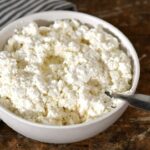Cottage Cheese Recipe
Traditional cottage cheese is made with buttermilk. It’s a low-lactose, rennet-free, and probiotic cheese! Cottage cheese makes a delicious snack, or press it into a firm, slicing cheese!
- Prep Time: 15 minutes
- Cook Time: 30 minutes
- Total Time: 45 minutes
- Yield: 6 cups 1x
- Category: Cheese
- Method: Clabbered
- Cuisine: Traditional
- Diet: Vegetarian
Ingredients
Units
Scale
- 1 gallon (4 liters) non-fat milk
- 1/2 cup cultured buttermilk (see notes)
- 8 cups of water
Instructions
- Pour milk and the buttermilk into a large pot. You will need enough room to add 8 cups of water so use a large soup pot. Leave the milk on the kitchen counter for 12 to 14 hours, until it has clabbered.
- Cut the clabbered milk into 1-inch curds. Heat 8 cups of water to 100 F, then add it to curds.
- Keep the curds at around 100F (38C). (See notes for suggestions on how to do this). Gently stir the curds every 5 minutes for 30 to 60 minutes. The curds will be finished cooking when they are separated from the whey and sink to the bottom of the pot. (See the photo above).
- Pour the curds into a cheesecloth-lined strainer. Rinse the curds with cold water, then allow to drain for 1 hour, until most of the whey is gone.
- At this point, you will have dry curd cottage cheese. See the section above for details on how to finish your cheese for creamy cottage cheese or pressed cheese.
Notes
- Don’t bother using higher-fat milk. The fat is drained off with the whey.
- If this is your first time making cheese, I recommend reading up on how to make cheese, for more details about each of the steps.
- It can be hard to find well-cultured buttermilk in the grocery store. I recommend testing store-bought buttermilk before using it to make cottage cheese. The easiest way to test buttermilk culture is to use it to make more cultured buttermilk. (I have found a brand that works… but I have also had failures with several local brands of buttermilk. Just having culture on the label doesn’t mean it’s a live culture.)
- This recipe results in creamy and delicious small curd cottage cheese. If you want to make large curd cottage cheese, see the section above for 3 additional steps that are a bit more advanced.
- Here are three options that I have used to keep curds at 100 F:
- Very low heat on the stove. This isn’t recommended for other types of cheese. However, the likelihood of burning the whey is reduced because there is so much water added to the pot.
- Place the pot in a sink filled with hot water. (Like a water bath or double boiler).
- Now I use my folding fermentation box, which makes everything easy!
Nutrition
- Serving Size: 1/2 cup
- Calories: 102
- Sugar: 0.4g
- Sodium: Optional
- Fat: 2.2g
- Saturated Fat: 1.4g
- Carbohydrates: 4.1g
- Fiber: 0g
- Protein: 15.5g
Find it online: https://www.fermentingforfoodies.com/homemade-cottage-cheese/
